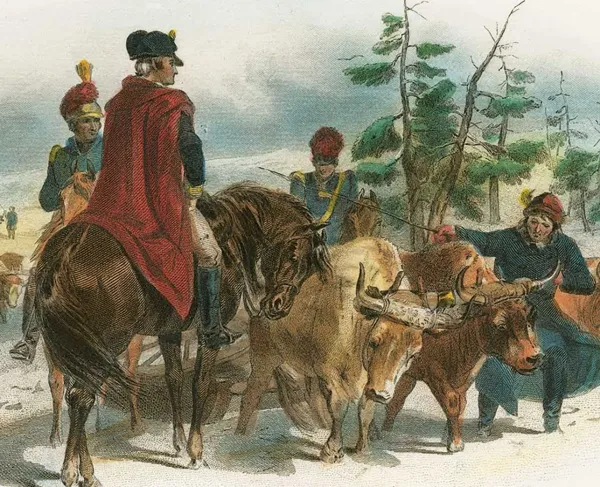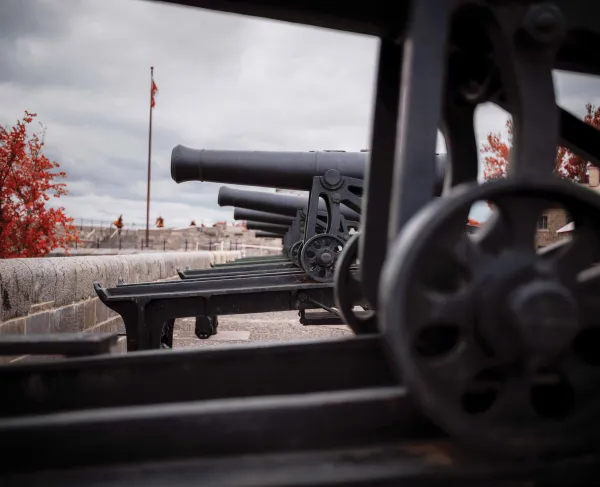Siege of Fort Ticonderoga

Fort Ticonderoga, derived from the Iroquois word meaning “between two waters,” was aptly seated at the confluence of Lake George and Lake Champlain. It had been a French fort, captured during the Seven Years War by the British. On May 10, 1775, the Green Mountain Boys, under command of Ethan Allen and Benedict Arnold, captured the fort in a surprise attack. Afterward, it became a symbol of American pride and strength.
The American garrison set to work strengthening the fort’s defenses. They built earthworks and redoubts on the banks of Lake Champlain, and especially fortified Mount Hope and Mount Independence, two of the hills overlooking the fort, with redoubts and cannon. Although Ticonderoga occupied a strategic position on the two lakes, it was vulnerable to attack from above. The Americans, under General Arthur St. Clair, believed the slopes of Mount Defiance were too steep for artillery and left it undefended.
General John Burgoyne, a new British commander, arrived in Canada in May 1777. His plan was to sweep down towards the Hudson River Valley and rendezvous with General William Howe, who would move north up the river from New York City, at Albany. By controlling the entire Hudson River, they would cut off New England, which was seen by the British as the heart of the rebellion, from the rest of the colonies. Burgoyne especially targeted Ticonderoga, as its strategic location gave it access to both Canada and the Hudson Valley.
Burgoyne divided his army, which totaled about 7,800 men, first sending an advance force of both British regulars and Native Americans under Brigadier General Simon Fraser. The left-wing of his main army, mainly compromised of Hessian and Brunswick mercenaries, was commanded by Baron Riedesel, and the right wing commanded by General William Phillips. The British occupied Crown Point on June 30, a fort north of Ticonderoga.
Aware of the impending British attack, St. Clair met with General Philip Schuyler, commander of the Northern Department, on June 20. They concluded that the approximately 2,500-3,000 men in the fort would not be enough to hold the fort against a sizeable British attack. Schuyler had previously requested more troops, but his superiors doubted the possibility of an overland attack. They planned two escape routes, one south, and one east, and strengthened the defenses on Mt. Hope. Mt. Defiance remained undefended for lack of men. However, Schuyler ordered, St. Clair should defend the fort as long as possible. After skirmishing with British forces to the west of the fort, St. Clair learned of the size of the British force from a captured redcoat.
At the same time, British engineers wheeled artillery to the top of Mt. Defiance, intending a surprise bombardment on the fort. Fraser also took Mt. Hope. But on July 4, thanks to British campfires, St. Clair caught sight of the guns. He now realized he was in an impossible position. He could either save his reputation and lose the army by putting up a defense or destroy his reputation and save the army by retreating. At a council of war, he decided to abandon the fort. In the early hours of the next morning, the fort was abandoned; sick and wounded, along with crucial supplies, were evacuated by boat, while the rest of the garrison marched east. Burgoyne’s men were in hot pursuit, and a few skirmishes would follow. Despite the Battles of Hubbardton and Fort Ann being British victories, the Americans inflicted higher casualties on pursuing British forces and secured their retreat to safety.
George Washington, the Continental Congress, and many Americans were infuriated by St. Clair’s decision, that he would surrender a crucial American stronghold without firing a shot. He and Schuyler were removed from command and court-martialed, and though they both were exonerated, neither of their reputations ever recovered from their disgrace at Fort Ticonderoga.





